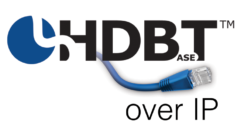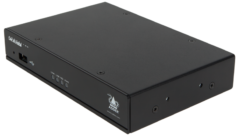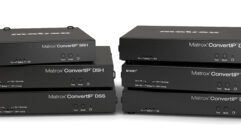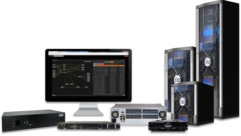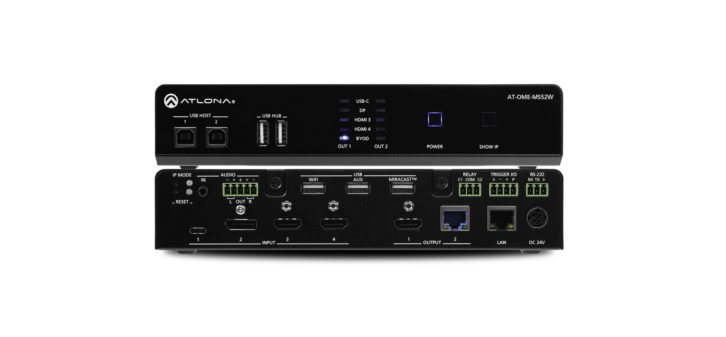 At ISE 2020, Atlona, a Panduit company, introduced the AT-OME-MS52W 5×2 matrix switcher, aimed at simplifying BYOD. The device combines flexible wired and wireless AV input support with USB extension and user convenience features such as automatic input selection and display control; it supports workflows from multi-participant presentations to video conferencing. Wired connections include HDMI, DisplayPort, and USB-C inputs alongside mirrored or matrixed HDBaseT and HDMI outputs. The USB-C port provides adapter-free AV input from tablets and laptops, as well as device charging. The USB-C interface also combines with the switcher’s integrated USB 2.0 hub to provide data connectivity for two peripheral devices, plus simultaneous AV and USB switching for up to three host computers, and USB extension to a compatible Atlona HDBaseT receiver. For wireless interfacing, the switcher has native screen mirroring for iOS, Android, Mac, Chromebook, and Windows devices without the need for a separate app. The switcher supports HDBaseT transport of video up to 4K/60 at 4:2:0 alongside embedded audio, control, Ethernet, and USB data (when paired with a USB-capable receiver). Wired AV inputs and the local HDMI output support 4K/60 4:4:4 at HDMI data rates up to 18 Gbps. Up to 16 devices can be previewed. The OME-MS52W can be remotely managed through the Atlona Management System (AMS 2.0) software or Atlona’s recently enhanced Velocity IP-enabled AV control platform; TCP/IP and RS-232 support enable integration with third-party control systems.
At ISE 2020, Atlona, a Panduit company, introduced the AT-OME-MS52W 5×2 matrix switcher, aimed at simplifying BYOD. The device combines flexible wired and wireless AV input support with USB extension and user convenience features such as automatic input selection and display control; it supports workflows from multi-participant presentations to video conferencing. Wired connections include HDMI, DisplayPort, and USB-C inputs alongside mirrored or matrixed HDBaseT and HDMI outputs. The USB-C port provides adapter-free AV input from tablets and laptops, as well as device charging. The USB-C interface also combines with the switcher’s integrated USB 2.0 hub to provide data connectivity for two peripheral devices, plus simultaneous AV and USB switching for up to three host computers, and USB extension to a compatible Atlona HDBaseT receiver. For wireless interfacing, the switcher has native screen mirroring for iOS, Android, Mac, Chromebook, and Windows devices without the need for a separate app. The switcher supports HDBaseT transport of video up to 4K/60 at 4:2:0 alongside embedded audio, control, Ethernet, and USB data (when paired with a USB-capable receiver). Wired AV inputs and the local HDMI output support 4K/60 4:4:4 at HDMI data rates up to 18 Gbps. Up to 16 devices can be previewed. The OME-MS52W can be remotely managed through the Atlona Management System (AMS 2.0) software or Atlona’s recently enhanced Velocity IP-enabled AV control platform; TCP/IP and RS-232 support enable integration with third-party control systems.
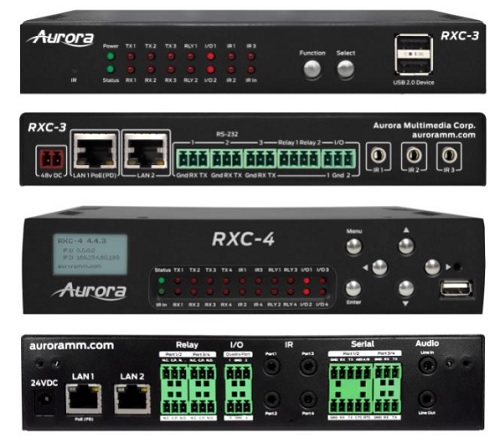 Just before ISE, Aurora Multimedia’s Paul Harris previewed the important developments he sees in underlying signal infrastructure for AV over IP. He noted that SDVoE was introducing the 10G technology in an ASIC IC, citing it’s potential reduced power consumption and pricing. Additionally, HDBaseT is demonstrating its third-generation HDBaseT, which can now do uncompressed 4K60 4:4:4, 1G Ethernet, and full 480Mbps over Cat cable. In this same category of infrastructure innovation, Harris puts ReAX by Aurora, which is an open-architecture IP control system that operates independent of Aurora, allowing other manufacturers to utilize it, creating interoperability of source code, macros, IR libraries, etc. At the show, the company showed four new ReAX control units for its web-based IP control system. For these units, custom programming and GUIs created with the free ReAX Core Studio software are loaded in to the built-in web server, allowing virtually any device with a web browser to display the GUI and control the system. Aurora describes the PoEenabled units as flexible enough to work as a full standalone controller, an expansion controller, or a hybrid. Aurora also introduced the new HT Pro Series HDBaseT transceiver wall plate for uncompressed 4K60 4:4:4 and also ReAX wall and desktop touchpanels at the show.
Just before ISE, Aurora Multimedia’s Paul Harris previewed the important developments he sees in underlying signal infrastructure for AV over IP. He noted that SDVoE was introducing the 10G technology in an ASIC IC, citing it’s potential reduced power consumption and pricing. Additionally, HDBaseT is demonstrating its third-generation HDBaseT, which can now do uncompressed 4K60 4:4:4, 1G Ethernet, and full 480Mbps over Cat cable. In this same category of infrastructure innovation, Harris puts ReAX by Aurora, which is an open-architecture IP control system that operates independent of Aurora, allowing other manufacturers to utilize it, creating interoperability of source code, macros, IR libraries, etc. At the show, the company showed four new ReAX control units for its web-based IP control system. For these units, custom programming and GUIs created with the free ReAX Core Studio software are loaded in to the built-in web server, allowing virtually any device with a web browser to display the GUI and control the system. Aurora describes the PoEenabled units as flexible enough to work as a full standalone controller, an expansion controller, or a hybrid. Aurora also introduced the new HT Pro Series HDBaseT transceiver wall plate for uncompressed 4K60 4:4:4 and also ReAX wall and desktop touchpanels at the show.
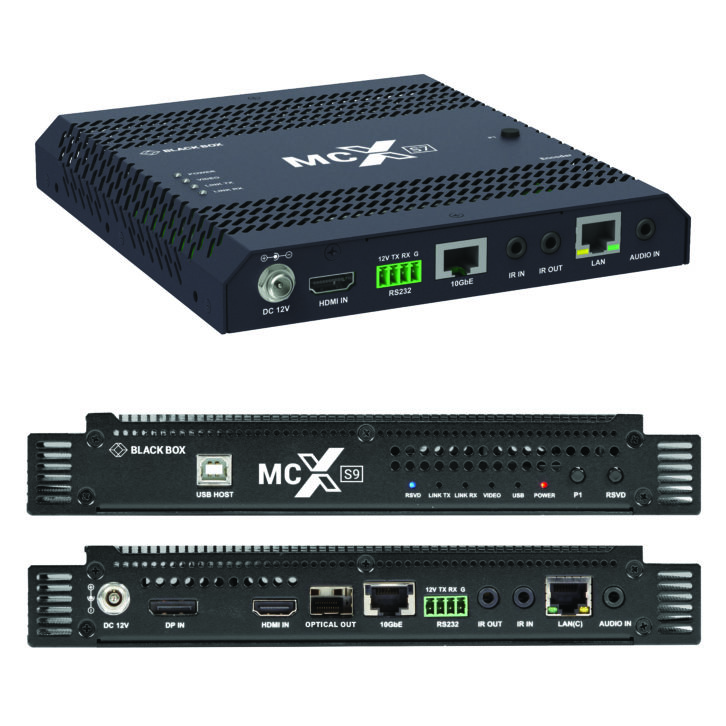 At ISE 2020, Black Box teamed up with NETGEAR and the SDVoE alliance to sponsor a series of Design Partner Certification Live Events. This partnership will continue with events throughout 2020 in cities worldwide. Shown at ISE 2020, the Black Box MCX multimedia distribution and management system takes advantage of SDVoE and modern 10 GbE infrastructure to allow AV and data payloads to exist on the same IT networks. Through advanced chipset technology, common control APIs and interoperability, SDVoE technology claims zero-latency and uncompromised video while offering significant cost savings along with enhanced system flexibility and scalability. While enabling truly converged network AV, Black Box MCX ensures supports instantaneous switching, bandwidth efficiency and high-quality video and audio. MCX simplifies and accelerates the process of consolidating AV and data on a single network, enabling organizations in virtually any industry to reduce network management time and costs, as well as total cost of ownership. Rather than deploy an entirely new network, users can take advantage of the software-defined solution to leverage existing infrastructure for delivery of better-quality audio and video.
At ISE 2020, Black Box teamed up with NETGEAR and the SDVoE alliance to sponsor a series of Design Partner Certification Live Events. This partnership will continue with events throughout 2020 in cities worldwide. Shown at ISE 2020, the Black Box MCX multimedia distribution and management system takes advantage of SDVoE and modern 10 GbE infrastructure to allow AV and data payloads to exist on the same IT networks. Through advanced chipset technology, common control APIs and interoperability, SDVoE technology claims zero-latency and uncompromised video while offering significant cost savings along with enhanced system flexibility and scalability. While enabling truly converged network AV, Black Box MCX ensures supports instantaneous switching, bandwidth efficiency and high-quality video and audio. MCX simplifies and accelerates the process of consolidating AV and data on a single network, enabling organizations in virtually any industry to reduce network management time and costs, as well as total cost of ownership. Rather than deploy an entirely new network, users can take advantage of the software-defined solution to leverage existing infrastructure for delivery of better-quality audio and video.
 DVIGear brought back it’s popular Formula IP showcase to ISE 2020; show participants drive a simulated HyperCar using DisplayNet for AV and USB extension and win prizes for their speed. The showcase serves as a demonstration of DisplayNet’s support for full 4K/60 resolution, with full USB 2.0 extension, zero-frame latency, and zero-artifact image quality. Also at the show, the company brought a new addition to the DN-200 Series of DisplayNet SDVoE products. The DN-200 Series offers an array of powerful features such as Fast Switching, Advanced Video Wall processing, and a customizable MultiViewer engine, replacing a myriad of dedicated units. New for this year, are the DN-225 transmitters and receivers, which offer both fiber and copper connectivity in the same compact, fanless form-factor as previous DN-200 Series devices. DN-225 transmitters and receivers are available now for immediate delivery. DVIGear also showed the affordable DN-150 Series and the DN-150-TX-Quad HDMI Input Module for the NETGEAR M4300-96X network switch. The team rolled out the latest improvements to DisplayNet Manager, a web-based User Interface for system set up and installation, as well as a simple and easy-to-use set of API commands that enable third party controllers to manage all aspects of the system.
DVIGear brought back it’s popular Formula IP showcase to ISE 2020; show participants drive a simulated HyperCar using DisplayNet for AV and USB extension and win prizes for their speed. The showcase serves as a demonstration of DisplayNet’s support for full 4K/60 resolution, with full USB 2.0 extension, zero-frame latency, and zero-artifact image quality. Also at the show, the company brought a new addition to the DN-200 Series of DisplayNet SDVoE products. The DN-200 Series offers an array of powerful features such as Fast Switching, Advanced Video Wall processing, and a customizable MultiViewer engine, replacing a myriad of dedicated units. New for this year, are the DN-225 transmitters and receivers, which offer both fiber and copper connectivity in the same compact, fanless form-factor as previous DN-200 Series devices. DN-225 transmitters and receivers are available now for immediate delivery. DVIGear also showed the affordable DN-150 Series and the DN-150-TX-Quad HDMI Input Module for the NETGEAR M4300-96X network switch. The team rolled out the latest improvements to DisplayNet Manager, a web-based User Interface for system set up and installation, as well as a simple and easy-to-use set of API commands that enable third party controllers to manage all aspects of the system.
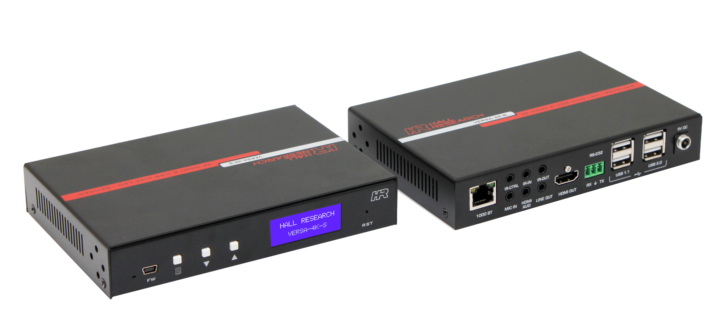 The Hall Research VERSA-4K is the latest addition to the company’s AV-over-IP product line. The VERSA4K system extends and switches multiple 4K HDMI video and USB data sources to virtually an unlimited number of receivers using simple Gigabit network switches. The Sender/Encoder accepts any HDMI resolution including 4K, 60 Hz 4:4:4 with HDCP 2.2. The Receiver/Decoder includes an HDMI output with extracted HDMI audio, bidirectional IR, RS-232, and 4 USB ports. In a 1-1 setup, just connect a Cat6 cable up to 120 meters (400 ft) between the two ends. In a many-to-many setup, a dedicated Gigabit network switch (with IGMP and Jumbo-frame support) is required. Free PC GUI is available for setup, configuration, and control of the system.
The Hall Research VERSA-4K is the latest addition to the company’s AV-over-IP product line. The VERSA4K system extends and switches multiple 4K HDMI video and USB data sources to virtually an unlimited number of receivers using simple Gigabit network switches. The Sender/Encoder accepts any HDMI resolution including 4K, 60 Hz 4:4:4 with HDCP 2.2. The Receiver/Decoder includes an HDMI output with extracted HDMI audio, bidirectional IR, RS-232, and 4 USB ports. In a 1-1 setup, just connect a Cat6 cable up to 120 meters (400 ft) between the two ends. In a many-to-many setup, a dedicated Gigabit network switch (with IGMP and Jumbo-frame support) is required. Free PC GUI is available for setup, configuration, and control of the system.
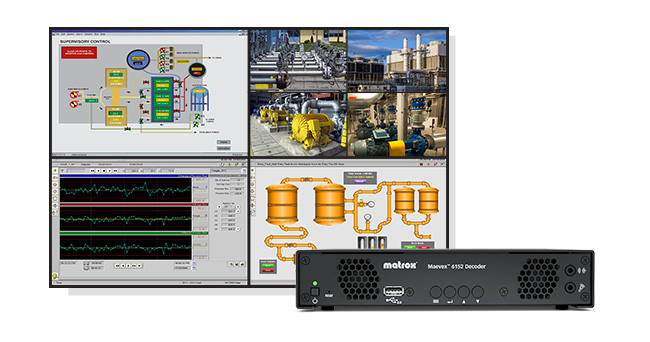 With its long-standing involvement in AV/IT, Matrox used ISE 2020 to showcase its full portfolio for capture, streaming, recording, extension, switching, decoding, display, and control for media-over-IP applications. Maevex and Monarch appliances showcased recording, webcasting, and lecture capture features. The new Maevex 6152 Quad 4K Decoder (coming in Q2) decodes up to four 4K streams—or many more lower resolution streams—across up to four 4K displays from a single, standalone appliance; the Maevex 6152 also includes HDCP support. In an application demonstration, Matrox paired up Maevex multi-4K encoders, Extio 3 IP KVM extenders, and Mura IPX capture and IP encode/decode cards to create a complete control room ecosystem to share information between operators and a video wall, and between local and remote video walls over LAN and Internet. Matrox also demonstrated an industry-unique KVM multi-system control feature: The new Aggregator Mode for Extio 3 enables the remote monitoring and control of a number of systems from a multi-display workspace with a single keyboard and mouse. In addition to announcing a major expansion to its video wall portfolio including QuadHead2Go multi-monitor controllers, Matrox presented an AVIXA AV/IT FlashTrack session titled “The Next Phase of AV over IP.”
With its long-standing involvement in AV/IT, Matrox used ISE 2020 to showcase its full portfolio for capture, streaming, recording, extension, switching, decoding, display, and control for media-over-IP applications. Maevex and Monarch appliances showcased recording, webcasting, and lecture capture features. The new Maevex 6152 Quad 4K Decoder (coming in Q2) decodes up to four 4K streams—or many more lower resolution streams—across up to four 4K displays from a single, standalone appliance; the Maevex 6152 also includes HDCP support. In an application demonstration, Matrox paired up Maevex multi-4K encoders, Extio 3 IP KVM extenders, and Mura IPX capture and IP encode/decode cards to create a complete control room ecosystem to share information between operators and a video wall, and between local and remote video walls over LAN and Internet. Matrox also demonstrated an industry-unique KVM multi-system control feature: The new Aggregator Mode for Extio 3 enables the remote monitoring and control of a number of systems from a multi-display workspace with a single keyboard and mouse. In addition to announcing a major expansion to its video wall portfolio including QuadHead2Go multi-monitor controllers, Matrox presented an AVIXA AV/IT FlashTrack session titled “The Next Phase of AV over IP.”
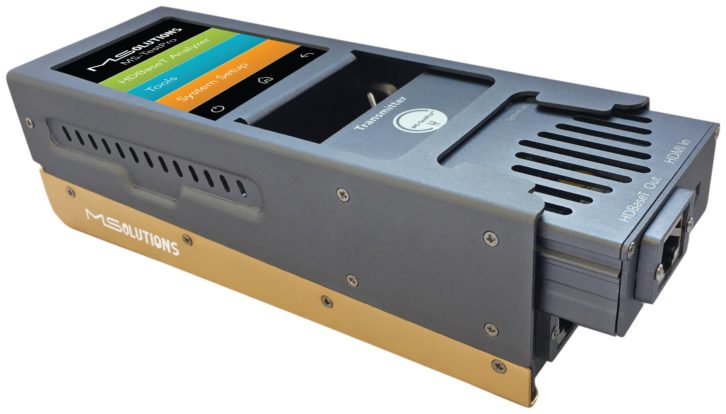 MSolutions unveiled several built-in and modular features to its MS-TestPro portable test device at ISE 2020. Like many other companies in AV Over IP, MSolutions has been active in HDBaseT development since the standard was introduced in 2010, and the MS-Test Pro device was introduced in 2017 to simplify the adoption and installation of HDBaseT media networks. The company has continued to add new features and modules that enable installers to test for other AV requirements using the same devices, including its specialized HDMI Cable Tester module, added last year, which allows integrators to efficiently perform bandwidth and physical layer quality tests. The HDMI Cable Tester drills down to each cable’s conductors and shielding, and provides instant feedback on missing or defective wiring. The module easily attaches to both ends of an HDMI cable, and delivers detailed information on HDMI bandwidth requirements, the presence of HDMI-standard conductors, and compatibility tests for signals up to 4K@60Hz 4:4:4 in the HDMI 2.0 specification. Now, and new at ISE 2020, the MS-TestPro is the first device of its kind to integrate AV over IP test capabilities into an HDBaseT device, eliminating the need for an expensive standalone IP tester. The software-driven capabilities, available to existing users via a simple software update, are activated upon connecting the device to a network switch. Once connected, the software provides immediate, detailed feedback on network switch information and settings, and a general overview of IP network conditions and connections. The information received allows integrators to quickly confirm if the network settings fit the AV over IP requirements. This includes identifying network configuration faults, the status of network ports (open or blocked), and whether pertinent multicast settings are correctly enabled.
MSolutions unveiled several built-in and modular features to its MS-TestPro portable test device at ISE 2020. Like many other companies in AV Over IP, MSolutions has been active in HDBaseT development since the standard was introduced in 2010, and the MS-Test Pro device was introduced in 2017 to simplify the adoption and installation of HDBaseT media networks. The company has continued to add new features and modules that enable installers to test for other AV requirements using the same devices, including its specialized HDMI Cable Tester module, added last year, which allows integrators to efficiently perform bandwidth and physical layer quality tests. The HDMI Cable Tester drills down to each cable’s conductors and shielding, and provides instant feedback on missing or defective wiring. The module easily attaches to both ends of an HDMI cable, and delivers detailed information on HDMI bandwidth requirements, the presence of HDMI-standard conductors, and compatibility tests for signals up to 4K@60Hz 4:4:4 in the HDMI 2.0 specification. Now, and new at ISE 2020, the MS-TestPro is the first device of its kind to integrate AV over IP test capabilities into an HDBaseT device, eliminating the need for an expensive standalone IP tester. The software-driven capabilities, available to existing users via a simple software update, are activated upon connecting the device to a network switch. Once connected, the software provides immediate, detailed feedback on network switch information and settings, and a general overview of IP network conditions and connections. The information received allows integrators to quickly confirm if the network settings fit the AV over IP requirements. This includes identifying network configuration faults, the status of network ports (open or blocked), and whether pertinent multicast settings are correctly enabled.
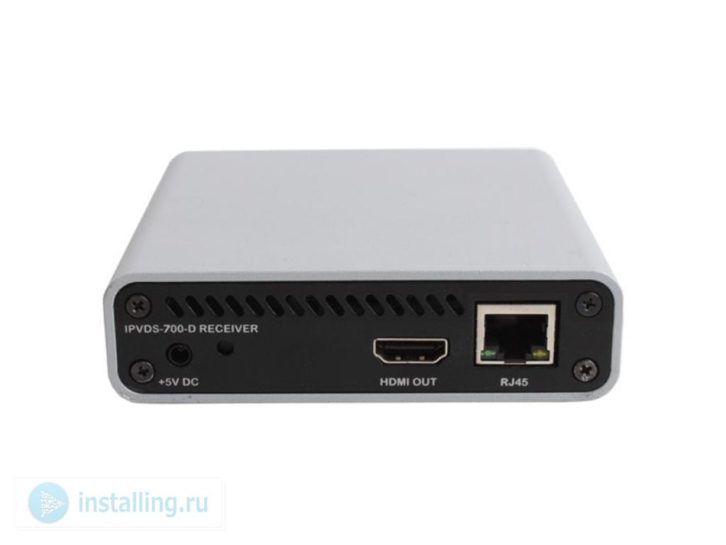 At ISE 2020, Opticis held several demonstrations including both HDMI 2.0 and DisplayPort 1.2 extension over fiber and IP Video Wall Controller with PoE feature. Opticis is known for the IPVDS-700-ED 4K HDMI IP Video Wall Controller, an integrated control solution that plays multi-source audio/video (such as PC, Media Player, DVD and Blu-ray) on the video wall system and multiple individual displays simultaneously. This solution provides advanced audio/video matrix feature as well as control. Multiple high-quality video sources (4K 30Hz or 1080p 60Hz) can be divided into multiple video walls with using IPVDS-700-E (Encoder) and IPVDS-700-D (Decoder). The controller enables convenient system configuration and control, and is positioned as a cost-efficient option for systems of all sizes. Interface is provided for system control offering preview function for source video as well as various display configurations such as merging and overlaying of displays, while allocating audio/video sources with simple drag and drop operation of mouse.
At ISE 2020, Opticis held several demonstrations including both HDMI 2.0 and DisplayPort 1.2 extension over fiber and IP Video Wall Controller with PoE feature. Opticis is known for the IPVDS-700-ED 4K HDMI IP Video Wall Controller, an integrated control solution that plays multi-source audio/video (such as PC, Media Player, DVD and Blu-ray) on the video wall system and multiple individual displays simultaneously. This solution provides advanced audio/video matrix feature as well as control. Multiple high-quality video sources (4K 30Hz or 1080p 60Hz) can be divided into multiple video walls with using IPVDS-700-E (Encoder) and IPVDS-700-D (Decoder). The controller enables convenient system configuration and control, and is positioned as a cost-efficient option for systems of all sizes. Interface is provided for system control offering preview function for source video as well as various display configurations such as merging and overlaying of displays, while allocating audio/video sources with simple drag and drop operation of mouse.
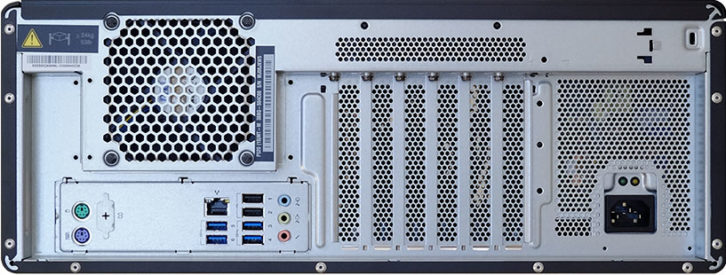 At press time, RGB Spectrum announced what the company describes as “the first full-function video wall processor fully integrated with an enterprise-class AV-over-IP video distribution platform.” The W4000 video wall processor is integrated into RGB Spectrum’s Zio AV-overIP platform. The W4000 video wall processor fully supports both baseband video sources (HDMI, DisplayPort, SDI) and AV-over-IP video sources (H.264) to deliver the best of both worlds for in-room and enterprise-wide video distribution. The W4000 simplifies complex visualization by simultaneously displaying multiple high-quality video sources onto any size video wall with up to 64 displays. The processor is the latest addition to the Zio AV-over-IP platform, a suite of hardware and software products optimized for Enterprise-Class video distribution. It is designed to accelerate collaboration by sharing information-rich visual displays across the enterprise and between organizations. Zio distributes video from baseband and IP sources across LANs, WANs, and to mobile devices. Integration with Zio enables the new W4000 processor and other video sources across the enterprise to be easily managed through a common browser-based interface.
At press time, RGB Spectrum announced what the company describes as “the first full-function video wall processor fully integrated with an enterprise-class AV-over-IP video distribution platform.” The W4000 video wall processor is integrated into RGB Spectrum’s Zio AV-overIP platform. The W4000 video wall processor fully supports both baseband video sources (HDMI, DisplayPort, SDI) and AV-over-IP video sources (H.264) to deliver the best of both worlds for in-room and enterprise-wide video distribution. The W4000 simplifies complex visualization by simultaneously displaying multiple high-quality video sources onto any size video wall with up to 64 displays. The processor is the latest addition to the Zio AV-over-IP platform, a suite of hardware and software products optimized for Enterprise-Class video distribution. It is designed to accelerate collaboration by sharing information-rich visual displays across the enterprise and between organizations. Zio distributes video from baseband and IP sources across LANs, WANs, and to mobile devices. Integration with Zio enables the new W4000 processor and other video sources across the enterprise to be easily managed through a common browser-based interface.

At ISE 2020, Tascam showed its range of devices for professional video playback, recording, and streaming without a computer, including the VS-R264 and VS-R265. These AV-over-IP streaming encoders/decoders offer simultaneous encoding, streaming, recording and decoding of audio/video material in 4K/UHD or Full HD resolution using H.265/HEVC or H.264 video codecs. The devices can be used for transmissions over corporate networks and WANs, or for live streaming into the Internet while simultaneously offering FTP upload of recorded files to network storage. Both models support Content Delivery Networks and online live platforms like YouTube, Wowza, Ustream, AWS Elemental MediaLive,

CloudFront and others. Both are PoE or 12V, with audio embedding and de-embedding. Control is via a RESTful API allowing for integration into automation and control systems. The devices support fully balanced audio I/O via Euroblock connectors, with configurable reference levels for compatibility with professional audio systems. Unbalanced 3.5-mm stereo mini jacks are also provided for compatibility with consumer devices. Compact at 1U, half-rack size they have attractive industrial design and can be mounted side by side. The newest addition to this line is the BD-MP1 Blu-ray player which plays a wide range of file formats from discs or SD cards and is suitable for touring or fixed installations.


